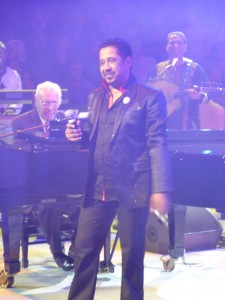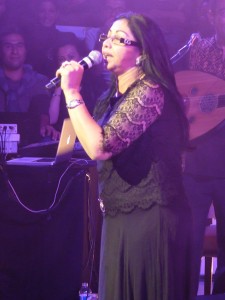The organization Festival d’Ile de France has been giving a spectacular series of concerts since September 5. I had the opportunity to hear Baaba Maal on September 11 (see my blog of September 12). Last Friday night, I heard Khaled and his friends at the Cirque d’Hiver. This concert was devoted to raï, a musical form that developed during the 1930s in the coffee houses and cabarets of Oran, in Algeria.
I was not sure whether I would even like this type of music, but, because the event promised a great line-up of raï stars, I figured that I had better get there to see for myself what it was all about.
The Cirque d’Hiver is a circus venue, built in Paris in 1852 and inaugurated by Prince Louis-Napolean . Today, it is still used for circus performances, as well as concerts. I imagine that France must have been a nation of small people at the time that the performance hall was built, because the seats are quite narrow and restrictive. My knees pushed against the back of the seat in front of me, and I had trouble placing my feet flat on the floor. During the show, however, I became so absorbed by the music that I largely forgot my discomfort.
As soon as Maurice El Medioni, the first performer to appear on stage, played his opening notes, a great roar arose from the audience, followed by shrill ululating. That high-pitched, trilling sound was an unmistakable signal that most of the spectators were Algerians or people of Algerian descent. It was also an indication that they knew that some wonderful music was about to be played!
Maurice El Medioni, a pianist born in Oran, is a specialist in Judeo-Arabian music. After he played the first number, he announced that it was a pure Andalusian melody. I found the music enthralling, even dreamy.
Then, just as El Medioni began another tune, the star of the show, Khaled, appeared at the top of a grand stairway to the wild acclamation of the audience. For the rest of the show, he would dominate the stage, singing with three other stars as they appeared in sequence. If Khaled is known to Americans, it would be for his popular song Aïcha, which came out in 1996. He sang this number, but for the most part his songs were in the rolling, rhythmic style of raï that sounds, to my ears, like wailing. This wailing sound is the reason why I thought that I might not enjoy the concert, but here, with it being performed live, I listened with fascination.
The three other performers were Cheb Sahraoui, also born in Oran, who was the first raï artist to tour North America; Boutaïba Sghir, who sings popular styles of raï; and Cheba Zahouania, one of the great female voices of this musical genre.
Toward the end of the show, the orchestra—consisting of musicians playing drums, bass, keyboard, accordion, guitar, derbouka (a percussion instrument), and oud (lute)—performed a number of melodies. One of the tunes sounded just like Latin jazz—all that was lacking was the brass!
By the end of the show, spectators were swaying in their seats, waving their arms, and dancing in the aisles. It was a great musical performance!
Like our blog? Join us on Facebook!



